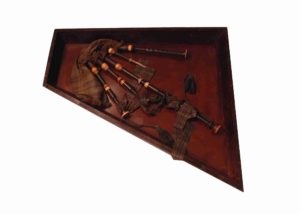Major-General David Stewart of Garth
Just before heading up the stairs to Gallery 4 visitors will see the painting of someone who, on first glance, might not look like a
Home » Blog » Black Watch History » A Very Brief War


In this blog Lieutenant General Sir Alistair Irwin, former Chairman of The Black Watch Museum Trust, discusses his decision to write the book ‘A Very Brief War’ and explains why he is donating proceeds from the sale to The Black Watch Castle and Museum.

In the late 1970s my grandfather showed me the photograph album that had belonged to his elder brother Lewis Cumming. It must have been given to Lewis when he first entered the then Royal Military College Sandhurst in 1911. There are several pages of photographs of his time as a gentleman cadet, as they were called in those days. These are followed by photographs from his early days in The Black Watch. The rest of the album is filled with documents collected by his father after his first-born son had been killed at the battle of the Aisne in September 1914. Many of these documents are letters written by or about Lewis.
Following my grandfather’s death, the album was handed down to me. I kept it with pride but did not think of doing anything with the fascinating and moving material that it contained. It was not until the approach of the commemorations of the centenary years of the 1st World War that it occurred to me that the contents of the album should be shared with members of the family. From 8th August to the date of his death I sent an email to them all explaining what Lewis was doing each day 100 years previously. This way we were all able to follow him from Aldershot, where the battalion was based, to Mons, and then through the retreat that ended with the battle of the Marne and finally the advance to the Aisne and his death on 14th September. He and the battalion had been in France for just 31 days. They had marched 325 miles and fought two minor engagements before their first major battle of the war on the Aisne.


This series of daily bulletins provided the inspiration to write the book. There was a lot more to tell, not least the story of how Lewis Cumming’s family at home on Speyside came to hear of the circumstances of his death. So I embarked more or less immediately on what turned out to be a very protracted project that has only now come to fruition. The process has been made both easier and more difficult by the internet: easier because the world-wide-web gives the researcher access to an unlimited supply of information; more difficult because the answer to one question inevitably leads to another question and so the research continues with curiosity never fully satisfied.
There is more to this book than the story of Lewis Cumming’s life and death. It is set in the context of what was going on at home and overseas. It does not pretend to be a detailed history of the reasons for the war or of its first few weeks but there is enough of the wider picture to give some sort of perspective to the actions of The Black Watch. I wanted also to give some feel for what it must have been like physically and mentally for Lewis and his men, so have included eye-witness descriptions of conditions under which they all operated. The text is liberally illustrated and a series of specially commissioned maps helping the reader to understand where everyone was as the story unfolds. Putting it all together has been a much longer process than I ever imagined but it has been more than worthwhile.

Having tested parts of it out on my teenage grand-daughter I hope that this is a book that can be read with interest by people of all ages. For those who already know a lot about the opening months of the 1st World War it provides a relatively rare insight into the experiences of the officers and men who did all the marching and all the fighting. For those whose knowledge is more limited I have deliberately included a wealth of fascinating material that may help to encourage more study and interest.
Although there may be further printings, possibly in a different format, this first edition runs to just 150 copies. Proceeds from sales will be donated to The Black Watch Museum Trust and I hope therefore that anyone buying the book may consider paying more for it than the asking price at the Castle Gift Shop or on-line. This would be in a very good cause because The Black Watch Museum, with its wonderful galleries of exhibits and its extensive archives, is the physical embodiment evidence of the remarkable history of the British Army’s senior highland regiment. The continuing life of the Museum pays tribute to that history as well as to all the tens of thousands of Black Watch men who helped make that history.
Lieutenant General Sir Alistair Irwin, KCB CBE
Dec 2019
Just before heading up the stairs to Gallery 4 visitors will see the painting of someone who, on first glance, might not look like a

Rosie Waine is the William Grant Foundation Research Fellow at the National Museum of Scotland. Here she writes how the Black Watch Museum & Castle
The Black Watch Museum archive holds a considerable quantity of primary source material relating to the Battle of Loos, 24th September 1915. This event has
Subscribe to Our Newsletter
© The Black Watch Castle and Museum
The Black Watch Regimental Trust is a charitable company registered in Scotland | Charity No: SC005848
